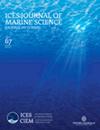Comparative phylogeography and genetic diversity of two co-occurring anti-tropical krill species Hansarsia megalops and Thysanoessa gregaria in the Atlantic Ocean
IF 3.4
2区 农林科学
Q1 FISHERIES
引用次数: 0
Abstract
Hansarsia megalops and Thysanoessa gregaria are two abundant krill species in the warm-temperate belts in the North and South Atlantic. This pattern of disjunct distribution, often referred to as anti-tropical (or bipolar), is a regular phenomenon among marine organisms that can appear at different taxonomic levels. Analysis of spatial genetic diversity based on variation of the mitochondrial cytochrome oxidase I (COI) gene was carried out to understand whether these broadly sympatric krill species have similar patterns in population structure and demographic history. The results suggested that the anti-tropical distribution of both species was driven by trans-equatorial migrations during different historical periods. We observed contrasting differences in genetic diversity between species coupled with similar patterns of genetic diversity and structure in disjunct populations on both sides of the equator. We also found additional genetically distinctive populations of T. gregaria in the South Atlantic in Subantarctic waters and showed that the Southern Subtropical Frontal Zone acts as a strong boundary between two genetically distinctive populations of T. gregaria. The results suggest that both species-specific habitat preferences and interactions between closely related species (congeners) may shape differences in population genetic diversity and structure among species.大西洋中两个共生的反热带磷虾物种 Hansarsia megalops 和 Thysanoessa gregaria 的比较系统地理学和遗传多样性
Hansarsia megalops 和 Thysanoessa gregaria 是北大西洋和南大西洋暖温带的两个丰富磷虾物种。这种不连续的分布模式通常被称为反热带(或两极),是海洋生物中的一种规律性现象,可出现在不同的分类水平上。根据线粒体细胞色素氧化酶 I(COI)基因的变异对空间遗传多样性进行了分析,以了解这些大致同域的磷虾物种是否具有相似的种群结构和人口历史模式。研究结果表明,这两个物种的反热带分布是由不同历史时期的跨赤道迁移驱动的。我们观察到物种间遗传多样性的对比差异,以及赤道两侧不相连种群中相似的遗传多样性和结构模式。我们还在南大西洋的亚南极水域发现了更多基因独特的 T. gregaria 种群,并表明南亚热带前缘区是两个基因独特的 T. gregaria 种群之间的强大边界。结果表明,物种特有的生境偏好和近亲物种(同源物)之间的相互作用可能会形成物种之间种群遗传多样性和结构的差异。
本文章由计算机程序翻译,如有差异,请以英文原文为准。
求助全文
约1分钟内获得全文
求助全文
来源期刊

ICES Journal of Marine Science
农林科学-海洋学
CiteScore
6.60
自引率
12.10%
发文量
207
审稿时长
6-16 weeks
期刊介绍:
The ICES Journal of Marine Science publishes original articles, opinion essays (“Food for Thought”), visions for the future (“Quo Vadimus”), and critical reviews that contribute to our scientific understanding of marine systems and the impact of human activities on them. The Journal also serves as a foundation for scientific advice across the broad spectrum of management and conservation issues related to the marine environment. Oceanography (e.g. productivity-determining processes), marine habitats, living resources, and related topics constitute the key elements of papers considered for publication. This includes economic, social, and public administration studies to the extent that they are directly related to management of the seas and are of general interest to marine scientists. Integrated studies that bridge gaps between traditional disciplines are particularly welcome.
 求助内容:
求助内容: 应助结果提醒方式:
应助结果提醒方式:


